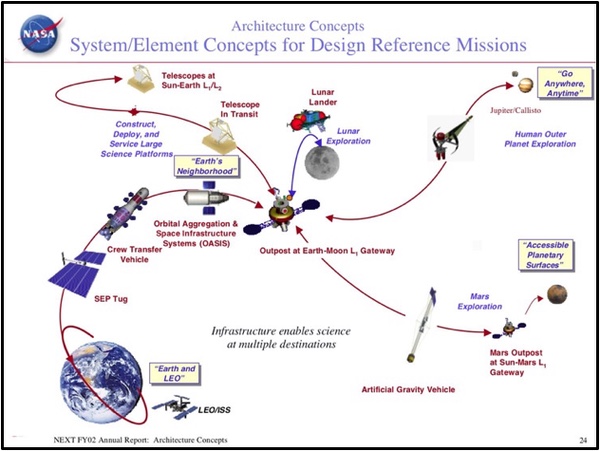Guarding Gateway’s goodness: protecting a steppingstone’s genuine utilityby Bob Mahoney
|
| Over the last two decades the original Gateway conception has weathered some tortuous re-branding and even re-lensing, all aimed at trying to shoehorn a foundationally sound idea into this or that White House administration’s preferences regarding what to do and where to go in space. |
Yet throughout all the rigmarole, the wording on NASA’s websites always referred to (sometimes thinly) the original DPT/NExT Outpost’s primary purpose: to serve as a transportation and servicing node specifically created to provide desired logistical, assembly, and tech-testbed leverage to robotic and crewed spacecraft going to and sometimes returning from various other locations. These locations include but are not limited to the lunar surface, the Earth-Moon and Earth-Sun Lagrange points, Mars, asteroids, and even the outer planets and moons. Recognizing the premise’s potential power, the DPT/NExT team members applied the term “gateway” from the beginning, echoing the pivotal role St. Louis played in the United States’ westward growth.
Addressing the erroneous
Before getting to my serious concern and this essay’s clarion call, I think it worthwhile to clear up some of the muddled misconceptions typically put forward by Gateway’s detractors. By speaking to these misrepresentations and misunderstandings I hope to illuminate the vital “whys” behind the Gateway and clarify some of its current particulars.
Gateway is not necessary.
“Necessary” is not an appropriate word here since the field of potential objectives in space is so vast and Gateway’s premise aims to contribute to many of them. “Necessary or not” can only usefully be directed toward a particular suggested solution to a specific individual objective. It wasn’t necessary that all my surgeries take place in hospital operating rooms nor my chemo regimens be administered by trained medical professionals, but it was certainly beneficial that they did and were, respectively.
There are multiple possible pathways to achieving the many remaining goals of space exploration and development. For example, SpaceX’s evolving broader vision may be a viable one for achieving numerous goals but not necessarily the best one for all possible players across all possible pursuits. (Acknowledging, mind you, that “best” is a nebulous term entangled in metrics of varying species.) The proper question to put forward at our current juncture is: What minimal near-term and long-term assets will contribute the greatest leverage toward efficiently achieving the broadest vision of sustainable solar-system-wide spacefaring activities by numerous participants?
Obviously, extremely inexpensive access both directions between Earth’s surface and space (LEO and beyond) is a biggie, if not the biggest. Until, however, and even after this presumed milestone is achieved, numerous in-space activities, not just those demanding lunar surface access, could benefit mightily in various ways from having an adaptable services and resources platform already situated at an energy-convenient ‘location’ outside of Earth’s deep gravity well.
Gateway’s only purpose is to be an occasional waiting place for an underpowered Orion.
The DPT/NExT Gateway proposal predates the birth of the CEV/Orion program by some years, so the implication that Gateway was created solely to support Orion (underpowered or not) is false. To further suggest that Gateway serves merely as a parking space for Orion or anything else oversimplifies current Artemis mission planning and ignores Gateway’s larger longer-term role. One irony embedded in this flawed criticism is that any “delta-velocity” exploitation of Gateway driven by Orion’s propulsion limitations—derived from a variety of unrelated causes—actually demonstrates Gateway’s utility on behalf of other possible spacecraft or missions heading down to (and/or back up from) the lunar surface or elsewhere.
Gateway is just a miniature ISS.
“Miniature” is an unhelpful and misleading Gateway characterization. Any facility ought to be as large or small as required to allow it to provide helpful functions at any given time. What is essential is that the facility be extensively modular so it can accommodate future servicing capabilities to support any number of varied users. It should also be capable of hosting advanced prototype space technologies for evaluation and ultimately incorporation both in itself and other spacecraft and missions.
The current working design, such that it is, does not preclude such features, though admittedly the usual published images do not immediately suggest such a spacecraft servicing facility. This is unfortunate. I wonder if this unmistakable exclusion reflects oversell worries at a government agency haunted by sweeping orbital vistas portraying Space Station Freedom Phase 2 decked out with multiple OTV hangers associated with the expansive (and doomed) Space Exploration Initiative. Gateway was born, remember, inside Administrator Dan Goldin’s DPT/NExT direction that they “sneak up on Mars.”
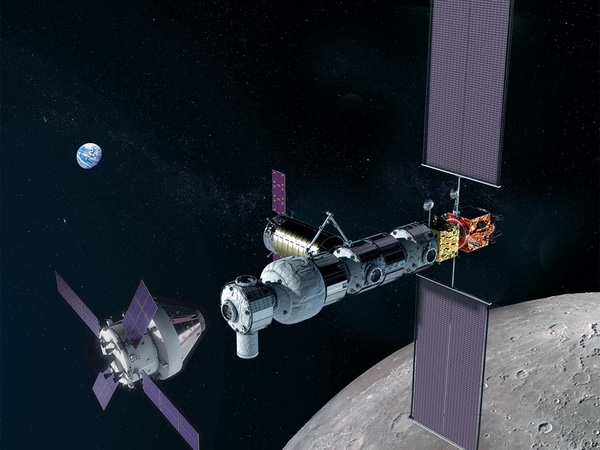 A typical NASA Gateway image. (credit: NASA) |
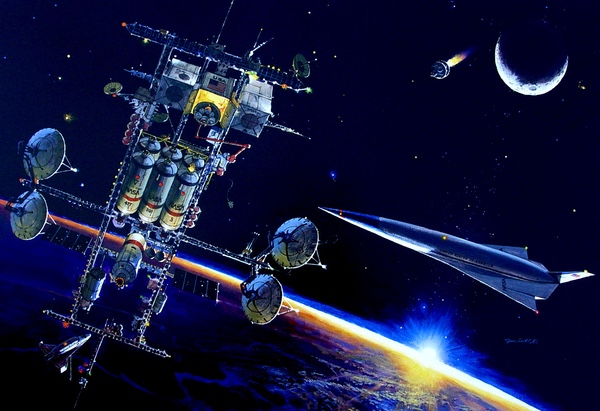 A rendering of Space Station Freedom Phase 2 (Advanced) by Robert McCall. Featured in Pioneering the Space Frontier (1986). |
As for the ISS comparison, Gateway is not another ISS, small or large, even if it may include similar elements and involve international partners. ISS is an orbiting laboratory focused largely on in-cabin and proximate external LEO experimentation and operations; Gateway is to be geared primarily toward providing external services to other spacecraft and missions going other places.
Yet the ISS, for all its tortuous implementation history and particular operational complexities and challenges, does serve to illustrate something of the nature and potential of Gateway’s envisioned supportive milieu.
Consider NASA’s Commercial Crew program and its byproduct, SpaceX’s independent commercial Crew Dragon flights. Inspiration4 unintentionally painted this analogy quite neatly via what it didn’t do. It lasted less than a week for a reason; as impressive as it is, Dragon is a limited design. Yet it can stay on orbit as an ISS ferry vehicle and lifeboat for months because it can dock to a facility able to provide resources which Dragon by itself does not sufficiently possess. Axiom’s long-term plans also illustrate the potential of such in-situ supportive capacity as well.
A decade or so earlier, docked shuttles and the ISS were able to provide leveraging support to each other in unanticipated ways just by possessing what they already had lying around, something analogous to Stephen Jay Gould and Richard Lewontin’s evolutionary spandrels. [9] Thanks to the shuttle’s fuel cells, ISS (whose life support system is not closed-loop) obtained water that otherwise would have been dumped overboard. Shuttle also, like Progress still today, provided ISS with periodic low-thrust orbit-altitude boosts with its vernier attitude control thrusters. In turn, ISS was eventually able to provide solar-derived electrical power to shuttles, thereby permitting conservation of fuel cell reactants and extending shuttle mission duration.
| But Gateway is not meant solely to serve early lunar surface missions, a common misconception. Any cislunar or beyond spacecraft or missions able to benefit from whatever resources and services Gateway can provide. |
And before ISS even came to be, the Space Shuttle’s mere existence as a substantial and relatively frequent LEO-access platform (despite its own historical and programmatic challenges) enabled the testing and use of many advanced space systems. Consider this limited spoonful of alphabet soup: EVA (spacewalking techniques); RMS (“robotics”); EASE/ACCESS (assembly); ORS (refueling demonstration); TSS (space tethers); MMU (EVA jetpack, employed in subsequent satellite servicing/recovery operations); HST (complex EVA repair and upgrade of free-flying spacecraft); OAST-1 (large deployable solar array testing); LDEF/WSF/SPAS/EURECA/SPARTAN (space environment or telescope free flyers); ORBT (improved rendezvous techniques); AFE (OTV aerobraking investigations–largely built but cancelled; the oft-flown Spacelab (numerous applications). Some of these exploitations of the shuttle’s “thereness” taught much or have found later application; some taught us what not to do; others remain to be fully tapped.
Gateway is meant (by design; spandrels will happen when they may) to offer such technical and operational capacity at a deep-space location, but with much more baked-in leverage for assisting a broader range of vehicles and missions heading farther out to numerous other locations. Former NASA Administrator Jim Bridenstine tried to sum up this substantial enabling utility with his—unfortunately limited—analogy comparing Gateway to the Apollo Command Module. [10] In its eventual availability to support early-on lunar surface sorties (of which he was speaking, I believe), the analogy is okay as far as it goes.
But Gateway is not meant solely to serve early lunar surface missions, a common misconception. Any cislunar or beyond spacecraft or missions able to benefit from whatever resources and services Gateway can provide will comprise its customer base. These utilities and services may range from the mundane and close by— local attitude control, communications, power, non-propellant spacecraft deployments akin to ISS cubesat launches)—to the exotic and far-reaching, like assembly, launching, and/or maintenance and refueling of both cislunar and interplanetary robotic and crewed spacecraft. Other unanticipated applications will likely arise.
In this vein, the recent nail-biting deployment of JWST served to highlight one of Gateway’s original inspirations: future, even larger telescopes or other spacecraft might be assembled in close Gateway proximity—enough to support EVAs if needed—before being sent on their way to more distant locations. [11a, b] Let us not forget that, after launch, one of Hubble’s solar arrays initially held up during deployment, prompting preparations for an EVA; the Compton GRO’s stuck antenna did require EVA crew intervention; and the AMS instrument on the ISS, which was not designed for servicing, required substantial delicate repair involving four complex and unprecedented spacewalks two years ago.
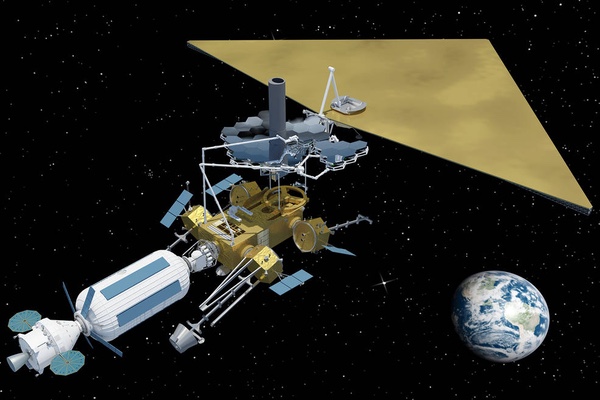 Illustration of a 20-meter observatory assembled in space. (Credit: NASA) |
Following initial deployment, from Gateway or not, these same future more capable telescopes or spacecraft might regularly return for servicing, refueling, or hardware upgrades to extend their lifetimes and even expand their range of inquiry.
As for supporting both short-term and extended lunar surface operations, including the essential eventual base establishment and growth, another earlier NASA administrator, Mike Griffin, offered his own thoughts. [12] He harshly criticized Gateway as not making sense until propellant can be manufactured on the lunar surface, at which point it could serve as an orbiting propellant depot. (Griffin held NASA’s reins when the 60/90/120-day ESAS effort brought forth his “Apollo on Steroids” for the Constellation program; this didn’t work out particularly well.) Respectfully, I see this assessment as unnecessarily narrow, even if it ultimately acknowledges the value of having a Gateway later and correctly points out the critical need to pursue and exploit lunar in-situ resources, as lunar ISRU may be the most impactful fulcrum for mastering the rest of the solar system.
As described above, Gateway isn’t only about getting back to the Moon. But even with lunar surface exploration and development, both near- and far-term, it makes sound technical sense to have available in an Earth- and lunar-surface-accessible lunar orbit certain operational resources, namely habitation, power, propulsive capability, and propellant and other consumables, initially delivered from Earth. At the very least, it will offer redundancy and flexibility, such as abort options, to any surface mission scenarios. The shuttle-ISS complimentary “utilities sharing” noted above and the Apollo 13 crew’s survival, which was absolutely dependent on the availability of their “lifeboat” lunar module, resound with this wisdom. (It is impossible to consider Apollo 13’s “successful failure” without remembering Apollo 8’s LM-less journey to and from lunar orbit.)
We should spend our limited available dollars directly on interplanetary, lander, and surface systems.
A facility designed to enable various users (e.g., not just SpaceX) to simplify their lander, surface, and interplanetary system designs is, by the very definition of the term, a steppingstone toward broader space exploration and development. Implementing such a facility would be a very wise investment of limited available dollars since it would allow multiple other users to reduce their costs, and thereby increase the chance of having more users to begin with. More players with more potential methods of achieving various goals means more opportunity for advancement and innovation. One of the most grievous and far-reaching blunders of earlier space efforts has been the persistent tendency to force programs to impose rigid penny-wise and pound-foolish technical choices on designs for the sake of annual budget expediency but which exclude designed-in flexibility and evolutionary opportunity that would likely reduce long-term cost and extend system lifetime.
Gateway will be out in the middle of nowhere.
I will try to restrain myself here as I’ve been in love with the elegance of celestial mechanics since high school when I learned of Gemini 4’s premature and perplexing real-time foray into the oft-counterintuitive nature of orbital maneuvering. [13] (Besides, studying orbits helped me improve my basketball shot!) What I will mostly do is point the reader to sources that elaborate on the technical history and utility of Gateway’s chosen reference orbit; the engineers and analysts themselves describe them well.
| Don’t get me wrong; I’m very excited about Starship. I am also aware, however, that after the Douglas DC-3 and decades later the Boeing Dash-80 each got into the air, all other aircraft did not become obsolete. |
To curtly characterize Gateway’s L2-Southern Near Rectilinear Halo Orbit (NRHO) as “being out in the middle of nowhere” reveals a seeming lack of understanding of Gateway’s baseline orbit and how it enables Gateway to support and enhance numerous mission applications. While the original DPT/NExT teams placed their Outpost at the L1 Lagrange point, Gateway’s NRHO preserves many of L1’s advantages and adds some more. As DPT/NExT had described, there is substantial energy-budget value and numerous other benefits available when exploiting Lagrange-point-associated celestial mechanics. In other words, space missions can save significant propellant, obtain advantageous geometries (including eclipse avoidance, long-duration communications line-of-sight, and positional stability), gain access to various abort options, and ride on interconnected “highways” of largely stable trajectories among gravitational sweet spots in both cislunar and interplanetary space. This all derives from the inherent dynamics of rotating celestial two-body systems (e.g., Earth-Moon, Sun-Earth, etc.) and it’s all out there for free.
Some background: See [14] for an adequate introduction to Lagrange points, those gravitational sweet spots in many two-body systems. For the basics of how spacecraft (and other objects) can orbit those empty sweet spots, see [15], which notes that the late Robert Farquhar (perhaps best described as the most iconoclastic genius in the field) first proposed in his 1968 PhD thesis an L2-halo-orbiting communications-relay satellite to support a far-side Apollo landing, the very scheme used for the recent Chinese farside lunar landing. His thesis is available for download.[16] More than 50 years ago, Farquhar described some of the advantages of placing a lunar space station in a halo orbit, versus the post-Apollo Mueller/Paine Integrated Program Plan’s low lunar polar orbit.[17] In 1984 Kathleen Howell discovered “almost” (near) rectilinear halo orbits and their remarkable properties.[18]
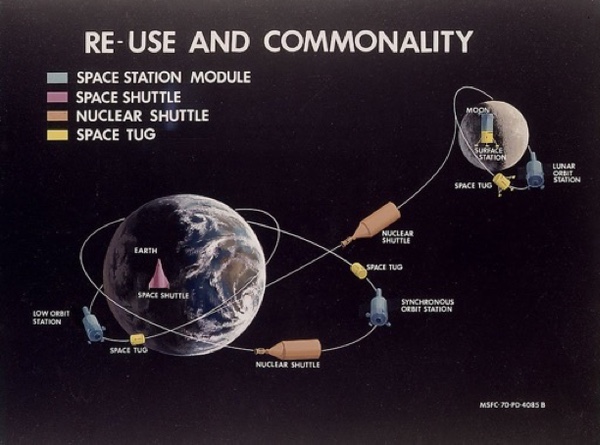 From the 1970 Integrated Program Plan (IPP), showing the lunar access portion of its “Space Transportation System.” Note Lunar Orbit Station in its low lunar polar orbit. (Credit: NASA) |
Two excellent sources for appreciating the so-called InterPlanetary Superhighway Network are a 2002 article by one of its original authors [19] and a 2004 video presentation by another.[20] One might say that Gateway will be situated close to an on-ramp of this celestial highway system.
About the Gateway NRHO and its utility: A 2015 paper by Whitley and Martinez [21] is a very helpful exploration of the trade-offs involved in selecting Gateway’s NRHO orbit from various alternatives. Note how the authors describe the family of L1-L2 NRHOs as “kind of bridges between L1 and L2 halos.” One significant consequence of this dynamic balancing act is that it allows a spacecraft to orbit nearly pole-to-pole over the Moon’s surface while keeping its orbital plane closely perpendicular to the rotating Earth-Moon line: that is, it still flies in an (albeit seriously elongated) halo around the Moon as seen from Earth. This feature affords numerous advantages for communications, thermal management, and abort options under the orbit’s flight path.
Another suite of consequences derives from the extremely high altitude and corresponding low orbital velocity at the NRHO’s farthest trajectory point—its apolune, aposelene, or apocynthion (pick your favorite term)—over the lunar south pole. These offer south-polar-site communications advantages (long “hang times”), reduces propellant requirements for lunar landers when they venture away from the orbit’s consistent (non-precessing) ground track, and reasonable propellant cost for getting elsewhere, including to and from Earth, compared to LLOs.
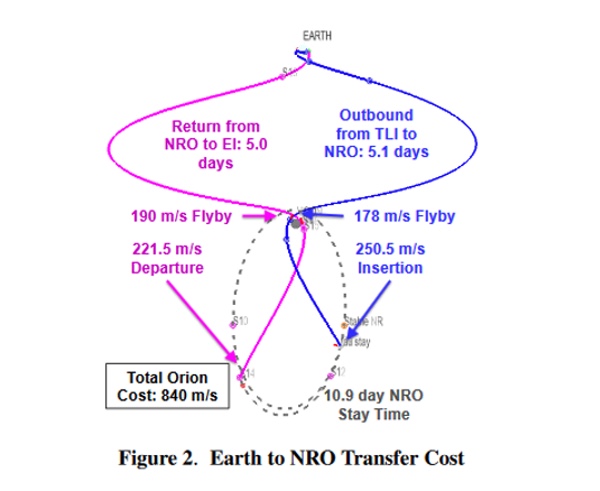 A diagram of Earth-NRHO transfer trajectories from [21]. |
In other words, the NRHO affords (to varying degrees) almost all the advantages of Farquhar’s classic L2 halo orbit against a polar LLO but ends up essentially being a polar lunar orbit anyway!
A 2019 white paper [22] formally describes the Gateway NRHO and includes a summary of why it was chosen, partly distilling the contents of the 2015 paper. I would also recommend that readers have a look at the following additional references that address various considerations of NRHOs so they can gain a fuller appreciation of these orbits’ utility.[23, 24, 25, 26, 27]
To sum up, a resources/servicing support facility placed in such an Earth-accessible polar L1-L2 “bridge” halo orbit offers to potential users relatively easy access, in terms of low required change in velocity and flexible burn-phasing, to a wide array of further locations, from the lunar surface to cislunar and interplanetary destinations. This is in addition to its other useful features. On the other hand, reusable spacecraft partaking of service facilities situated on Earth, in LEO, in LLO, or on the Moon before embarking on deep-space missions would, for many mission scenarios, incur additional propellant, timing, and/or structural mass penalties.
In a time when 100-person Starships are sailing between the Earth, the Moon, and the planets, we don’t need a Gateway located between worlds.
At least a few Starship supporters quick to dismiss other approaches say things like this with remarkable frequency. I hate to break the news, but we are not in a time when 100-person Starships are sailing between the Earth, the Moon, and the planets. So far only one crewless—and cabinless—Starship prototype has successfully landed (and not blown up) following a test flight to an altitude of about ten kilometers. Perhaps we should wait for at least one successful orbital flight before we declare such a time is upon us.
Don’t get me wrong; I’m very excited about Starship. I am also aware, however, that after the Douglas DC-3 and decades later the Boeing Dash-80 each got into the air, all other aircraft did not become obsolete. It would be wise, I think, to do what we can to enable as many avenues of exploration, development, and especially innovation as is practically possible. This was a large portion of Gateway’s impetus.
Starship is envisioned as an all-in-one spacecraft, in some ways not unlike the Space Shuttle. But others who seek to reach the Moon and beyond with smaller budgets and lesser objectives might choose to separate their vehicle functionalities and thereby simplify their approaches. Such lower-end spacecraft—many are out there and surely more will come—could benefit from a “service station” closer to their intended destinations or operational locales. Apologies for using an old analogy, but it still applies: few folks complete cross-country road trips without partaking of available resources and services along the way. Fewer still replenish from other vehicles dispatched from home rolling along the highway beside them.
| Successfully creating a sustainable deep-space operations capability will almost inevitably require a longer-term and broader experience of deep space. |
I personally am not confident that a sustainable space operations architecture can be achieved entirely with a ground-based approach. Earth’s atmosphere and deep gravity well imposes an awful lot of structural and technical overhead, not to mention wear and tear, upon every vehicle. Space engineers a long time ago came to appreciate the advantages and elegance of modular design. Much can be gained when the up/down solutions are distinct from the in-space solutions, and when the point-to-point distances for every mission component don’t stretch all the way back down to a launch pad or pads on the Earth’s surface.
The option of in-space assembly (now approaching a scientific art thanks to ISS) also begets flexibility in launch vehicle selection and final system configuration. The original DPT/NExT Outpost was to be launched in pieces entirely on multiple Delta IV Heavy boosters. Now the first Gateway components are slated to fly on a Falcon Heavy with others to be launched otherwise. Logistics supplies will follow first on Falcon Heavy but likely later on a cadre of different launchers. Gateway’s availability on the top end of Earth’s gravity well will allow other modular systems to follow likewise in its wake, launched piece by piece on various boosters, assembled, and then tested in deep space prior to committing them to going further.
Long-term reusable lunar landers and the entire regular mission sequencing of them would benefit mightily from the landers being inspected, serviced, and refueled closer to the Moon. While such lander servicing will likely eventually transition to facilities on the lunar surface, what of the interim? And other spacecraft, such as orbit transfer vehicles and large telescopes, likely won't have the option of descending to a nearby planetary surface for such regular servicing.
As for being “located between worlds,” does it not make sense to carefully build up our experience base in an environment wherein we intend to conduct more and more activity? We are speaking of a free-space region through which only a limited number of humans have thus far quickly transited and in which we’ve conducted but three actual EVAs. Back when we had so little actual space mission experience, Gemini filled this critical role to help Apollo reach the Moon. Similarly, decades of shuttle operations laid the foundation for the almost-routine ISS LEO operations occurring today, which in turn are providing some groundwork for other activities to come. Our current maturity in space operations—in the limited number of places we have such maturity—should not blind us to just how much difficult trailblazing experience it took to get us here.
Successfully creating a sustainable deep-space operations capability will almost inevitably require a longer-term and broader experience of deep space. The temporary habitation capacity of Gateway will permit both short- and long-term hands-on assessments of hardware, procedures, and crew in this environment while remaining relatively close to home, prior to committing to multi-million-kilometer journeys across the vast gulfs between planets. This, too, was part of Gateway’s original conception: a technology testbed platform to gain much-needed experience with new equipment and procedures that will serve future and farther exploration and development.
After spending more than $100 billion on an ISS that is now a burden to maintain a mere 400 kilometers away, we don’t need to spend that much on a smaller station hundreds of thousands of kilometers away.
I do not consider ISS a “burden.” It has untapped potential, surely, and it was and is more expensive than anyone wanted. But a burden? One could argue that carrying a child in one’s arms is a burden, but said burden comes with substantial benefits. Life is like that; so is pursuing any challenging worthwhile activity. Some of the ISS “burden” has and is shaping better ways and means of accomplishing future tasks and objectives. As Henry Petroski describes in To Engineer is Human: The Role of Failure in Successful Design (1985), missteps and even failures in any pursuit often help us advance toward better solutions.
As for past and current costs and all the other difficulties, one can hope that the financial and management lessons from the past will actually be learned, though I’m not holding my breath, either. History has seemingly taught us that any large proposed government space project usually experiences one of three possible outcomes:
The first outcome is how Apollo unfolded, with a bold urgent definitive goal and a focused commitment of substantial resources. Mercury might be classified as another. (I would place Gemini under Apollo’s umbrella.) Given Apollo’s (and Mercury’s) many unique converging historical circumstances, and barring some external globe-threatening catastrophe, this outcome may never happen again.
The second outcome is sticker-shock death due to denial of adequate funds for too big an ask. This happened to the 1970 IPP and 1989 SEI.
The third outcome is a painfully common one. First, initial overselling of the project leads to add-on accommodations that drive extraneous and/or mutually incompatible requirements. This initial ballooning of and conflict amongst mission objectives runs parallel to both perennially limited budgets and politically expedient “creativity.” To attempt to make everybody happy the original technical premise gets diluted by committee into a deflated compromised design whose realized implementation finally muddles along as best it can with what it became. The program typically ends up costing more than the original program’s projections. While the program achieves worthwhile and even significant goals, these rarely reach the full measure of the program’s original vision or intent. The Space Shuttle and Space Station Freedom’s transition to the ISS fall into this category.
One hidden crossover twist is that both the shuttle and ISS were handicapped orphans of the grand but swiftly dismissed Mueller/Paine Integrated Program Plan. They merely arrived, in staggered fashion, decades later, and both had suffered compromising dilution. ISS, like Shuttle before it, morphed into something significantly different from its original conception.[28, 29]
During the 2000s, in an even more convoluted self-destructive way, it happened again to Constellation. Its rockets (Ares V becoming SLS), spacecraft (CEV becoming today’s Orion, and the lunar lander Aquila cancelled), and lunar base transformed or evaporated along the writhing government way from VSE’s “Moon, Mars & Beyond” to ESAS’s Apollo on Steroids through the Asteroid Redirect Mission’s Plan B to Artemis. We find ourselves today with Constellation’s flotsam and jetsam.
| There is a very great danger that Gateway may morph into something different from what it should be. |
Unlike Constellation and its one crewless test flight, the shuttle and ISS accomplished and taught us much about how to do things better in space despite the pain, frustration, and cost, including tragic loss of life. Chesterton said, “If a thing is worth doing, it is worth doing badly.”[30] I would hold that conducting frequent, varied, complicated, and useful space operations on a near-continuous basis for forty years has been worth doing, STS and ISS dilutions notwithstanding.
The technical manifestations of the shuttle and station dilutions, though, are not as important as the reality that they actually did occur. This fact harbors my primary fear regarding Gateway.
The all-too-typical government program tendency
There is a very great danger that Gateway may morph into something different from what it should be. NASA is a government agency and so is prone to the way things work in Washington. For more than 60 years, NASA’s problems have come from both without and within; it is the nature of the bureaucratic beast. Said beast (NASA, Congress, the White House, industry, etc.) can indeed accomplish great things: Apollo 8 and Apollo 11 are watershed achievements for the ages. But such great accomplishments will only come when all the persons involved sufficiently get along, think clearly enough, and stay on-task, pursuing worthwhile goals. All who have their fingers in the space pie must be held accountable for what comes out of the oven. We must hold them accountable.
What should come out of the Gateway oven is a flexible modular facility designed to meet the original DPT/NExT intent for it, which I’ve attempted to highlight above. Those team members more than 20 years ago were well aware of what had happened to IPP, SEI, Shuttle, and ISS. They carefully conceived the steppingstone Gateway Architecture to chart a smart, forward-thinking, technically driven path which ought to avoid the traps and pitfalls of the more problematic alternatives.
I suspect that more than a few critics know full well what Gateway is supposed to be but have already admitted defeat to the notion that it will happen again, that it will become yet another mushed-up, diluted, and unnecessarily expensive program that appears only to serve itself. Such a calamity isn’t hard to imagine; most of the notional Gateway artwork splashed on websites and print media—which only show ISS-like modules with the Power and Propulsion Element but no recognizable servicing facilities—seem to presume it already has happened.
I don’t want that Gateway either.
A clarion call to guard Gateway’s goodness
We must all be vigilant, loud, and, most of all, accurate in our warnings, corrections, and advocacy as we fight to protect a foundationally sound idea aimed at effectively advancing space exploration and development. I would implore any persons who have denied the value of Gateway to fully inform themselves of its promise and reconsider it as the broad enabling helping-hand opportunity that it could and should be for many possible space ops players beyond LEO. Whatever other possible solutions exist for various space applications, the Gateway steppingstone concept merits a more thorough evaluation than simply dismissing it out of hand.
Instead, in concert with those already convinced of its substantial potential value, I am hoping that you—we—will everywhere defend its original intent and purpose against bureaucratic creep born of small, muddled, or lazy thinking—or worse. We must not let bureaucrats, politicians, ineffective managers, sloppy journalists, or anyone else with any authority or influence, turn Gateway into what some already think it has become.
It’s not too late—yet.
References
[1] Bob Mahoney, Names that maim: rebranding the Lunar Orbital Platform-Gateway (2018).
[2] Preface, Radio Replies, Vol. 1, (1938), Sheen.
[3] NASA, Lunar L1 Gateway Conceptual Design Report (2001); The original formal Gateway description.
[4] Dwayne A. Day and Jeff Foust, Forging a vision: NASA’s Decadal Planning Team and the origins of the Vision for Space Exploration (2005).
[5] NASA, NASA's Decadal Planning Team and the Policy Formulation of the Vision for Space Exploration, DPT/NExT original documents available here.
[6] Glen R. Asner and Stephen J. Garber, Origins of 21st-Century Space Travel (2019).
[7] Harley Thronson and Ted Talay, “Gateway” architectures: a major “Flexible Path” step to the Moon and Mars after the International Space Station, (2010); it proposed integration of ESAS-begotten Constellation systems into Gateway implementation…before things got plain ISS-ARM-DSG-DST-Mars weird.
[8] John Connolly, Deep Space Transport (DST) and Mars Mission Architecture (2017); NASA slides outlining an SLS-supported thread from ISS to Mars before ARM was nixed. https://nvite.jsc.nasa.gov/presentations/b2/D1_Mars_Connolly.pdf.
[9] Stephen Jay Gould, The exaptive excellence of spandrels as a term and prototype (1997).
[10] Jeff Foust, Is the Gateway the right way to the moon? (2018), Foust; mentions Bridenstine’s Command Module analogy.
[11a] Nick Siegler, Building the Future: in‐Space Servicing & Assembly of Large Aperture Space Telescopes (2018), Slides from a presentation at a Caltech conference on direct exoplanet science.
[11b] Jeff Foust, Repairing, and building, future space telescopes (2019).
[12] Eric Berger, Former NASA administrator says Lunar Gateway is “a stupid architecture”, Ars Technica (2018).
[13] Barton C. Hacker and James M. Grimwood, On the Shoulders of Titans: A History of Project Gemini (1977); The relevant passage is in Chapter 11 Section 2, Four Days and a Walk
[14] Lagrange point overview.
[15] Halo orbits overview.
[16] Robert Farquhar, The Control and Use of Libration-point Satellites (1968), (Farquhar’s original PhD thesis on libration point and halo orbit applications).
[17] Robert Farquhar, The Utilization of Halo Orbits in Advanced Lunar Operations, (1971).
[18] Kathleen Connor Howell, Three-Dimensional Periodic Halo Orbits (1984), (Howell’s original discovery of NRHOs)
[19] Martin W. Lo, The InterPlanetary Superhighway and the Origins Program (2002).
[20] Shane Ross, The Interplanetary Transport Network: Space Transportation for the 21st Century (2004).
[21] Ryan Whitley and Roland Martinez, Options for Staging Orbits in Cis-Lunar Space (2015).
[22] NASA, Gateway Destination Orbit Model: A Continuous 15 Year NRHO Reference Trajectory (2019).
[23] Jacob Williams et al., Targeting Cis-Lunar Near Rectilinear Halo Orbits For Human Space Exploration (2017).
[24] Clark P. Newman et al., Stationkeeping, Orbit Determination, and Attitude Control for Spacecraft in Near Rectilinear Halo Orbits (2018).
[25] Ryan J. Whitley et al., Earth-Moon Near Rectilinear Halo And Butterfly Orbits For Lunar Surface Exploration (2019).
[26] Diane C. Davis et al., Phase Control And Eclipse Avoidance In Near Rectilinear Halo Orbits (2020).
[27] Ethan W. Kayser et al., Navigation and Mission Design for Low-Thrust Insertion into Near Rectilinear Halo Orbits (2021).
[28] NASA, Shuttle Program History from NASA’s Exploring the Unknown Series.
[29] NASA, Space Operations Center, a concept analysis (1979). It is difficult to choose a specific example to represent “the original” conception for Station. It is something of the flavor of the original IPP first station.
[30] G.K. Chesterton, What’s Wrong with the World (1910).
Note: we are using a new commenting system, which may require you to create a new account.
